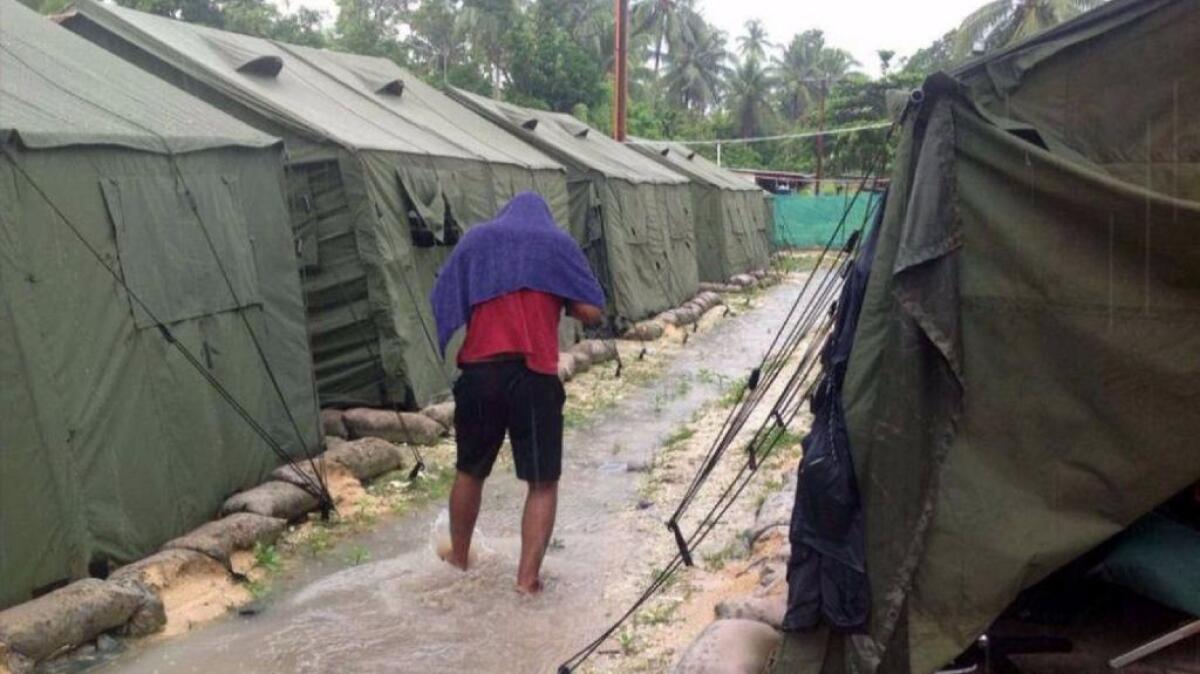First group of refugees heads from Pacific camps to U.S. under deal Trump slammed as ‘dumb’

- Share via
The first refugees accepted under a contentious agreement with Australia are headed to the United States, months after President Trump assailed the deal as “dumb” and not in the country’s best interests.
Fifty-four asylum-seeking refugees left Pacific island camps this week where Australia had housed them for several years. Some came from an all-male camp in Papua New Guinea’s Manus Island, while the others came from a camp on the island of Nauru, a U.S. State Department official said on Thursday. A number of advocacy groups have said the refugees are set to settle in cities from Los Angeles to Atlanta.
For the record:
1:30 a.m. June 11, 2025An earlier version of this report shouldn’t have specified that 25 of the refugees came from Manus Island and 27 from Nauru. Some were from Manus and the others from Nauru.
The resettlement of the refugees, mostly men from countries such as Iran, Afghanistan, Pakistan, Iraq and Somalia, is part of a deal forged between the United States and Australia under the Obama administration.
Under the agreement, about 1,250 refugees who have been refused entry to Australia and are housed in offshore detention centers will be accepted by the U.S. In exchange, Australia will accept Honduran and Salvadoran refugees under a U.S.-led resettlement program from a camp in Costa Rica.
Shortly after his inauguration, Trump tweeted he would “study this dumb deal,” raising concerns that he might nix it. And in his first conversation with Australian Prime Minister Malcolm Turnbull, Trump heatedly accused Australia of trying to export the next Boston Marathon bombers to America.
“Does anybody know who these people are? Who are they? Where do they come from?” he said, according to transcripts of the call obtained by the Washington Post. “Are they going to become the Boston bomber in five years? Or two years? Who are these people?”
Trump added, “We are like a dumping ground for the rest of the world. I have been here for a period of time; I just want this to stop. I look so foolish doing this.”
On Wednesday, the Trump administration announced it will limit refugee admissions to about 45,000 in the coming fiscal year, which is down sharply from the 110,000 cap in President Obama’s last year in office. A State Department official said that total would include the refugees from Australia. For now, no time frame has been announced for when the remaining refugees will be resettled from the Pacific islands to the United States.
Since his inauguration, Trump, who has relentlessly touted an “America first” nationalist agenda, has signed several executive orders barring entry to travelers from several majority Muslim countries. On Sunday, Trump announced a new ban on travel to the U.S. by nationals from majority Muslim countries as well as North Korea and Venezuela.
The refugees arriving this week are the collateral damage in Australia’s widely criticized “Stop the Boats” policy, the rule that asylum seekers who try to reach Australia by sea will not “make Australia home,” even if they are genuine refugees, are children or have skills.
Many of the asylum seekers have reportedly endured harsh treatment in the refugee camps. Cases of depression and self-harm are high, according to reports that have been leaked from the centers.
Amnesty International and Human Rights Watch published a report last year which found that Australia inflicted suffering on refugees and asylum seekers “in what appears to be a deliberate policy to deter further asylum seekers from arriving in the country by boat.” At the time, the U.N. high commissioner for refugees said that prolonged detention on the islands was “immensely harmful,” and called for refugees and asylum seekers to be moved and treated humanely.
Ian Rintoul, a spokesman for the Refugee Action Coalition, which is based in Sydney, said the arrival of the refugees associated with the Australia agreement is a positive.
“But the movement of just 50 people shows the level of uncertainty that surrounds the deal with the USA,” he said.
“It has been 10 months since the refugees had their first interviews, and there is no indication of when any more refugees who have applied will be accepted into the U.S.,” he said.
Rintoul said the Australian government should remove the remaining refugees from the island encampments.
“The refugees on Manus and Nauru remain the responsibility of the Australian government,” he said. “The government should make sure that no one is left behind. All the people on Manus and Nauru should be brought to the mainland while the government makes arrangements for those who want to go to the USA.”
Eric Ferrero, deputy executive director at Amnesty International USA, said the organization was “heartened to see people who have endured so much finally find safety in the U.S.”
“Both Australia and the United States need to do much more in the face of this crisis,” he said. “President Trump’s decision to cap refugee numbers at historic lows during the worst refugee crisis in generations is like throwing gasoline on an already raging fire. We cannot allow desperate people to be left in misery.”
Twitter: @kurtisalee
ALSO
Trump plans to slash refugee admissions by more than half
As U.S. retreats from refugee resettlement, humanitarians urge more compassion for world’s neediest
How the travel ban left a family of Iranian refugees stranded in Turkey
UPDATES:
1:00 p.m.: This article was updated with comments from Amnesty International and additional details.
This article was originally published at 10:20 a.m.
More to Read
Sign up for Essential California
The most important California stories and recommendations in your inbox every morning.
You may occasionally receive promotional content from the Los Angeles Times.














